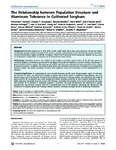Please use this identifier to cite or link to this item:
http://www.alice.cnptia.embrapa.br/alice/handle/doc/894831| Title: | The relationship between population structure and aluminum tolerance in cultivated sorghum. |
| Authors: | CANIATO, F. F.  GUIMARAES, C. T.   HAMBLIN, M.   BILLOT, C.   RAMI, J.-F.   HUFNAGEL, B.   KOCHIAN, L. V.   LIU, J.   GARCIA, A. A. F.   HASH, C. T.   RAMU, P.   MITCHELL, S.   KRESIVICH, S.   OLIVEIRA, A. C. de   AVELLAR, G. de   BORÉM, A.   GLASZMANN, J.-C.   SCHAFFERT, R. E.   MAGALHAES, J. V.   |
| Affiliation: | FERNANDA F. CANIATO, BOLSISTA; CLAUDIA TEIXEIRA GUIMARAES, CNPMS; MARTHA HAMBLIN, CORNELL UNIVERSITY; CLAIRE BILLOT, CIRAD; JEAN-FRANÇOIS RAMI, CIRAD; BARBARA HUFNAGEL, UFMG; LEON V. KOCHIAN, CORNELL UNIVERSITY; JIPING LIU, CORNELL UNIVERSITY; ANTONIO AUGUSTO F. GARCIA, ESALQ; C. TOM HASH, ICRISAT; PUNNA RAMU, ICRISAT; SHARON MITCHELL, CORNELL UNIVERSITY; STEPHEN KRESOVICH, CORNELL UNIVERSITY; ANTONIO CARLOS DE OLIVEIRA, CNPMS; GISELA DE AVELLAR, Pesquisadora aposentada - CNPMS; ALUÍZO BORÉM, UFV; JEAN-CHRISTOPHE GLASZMANN, CIRAD; ROBERT EUGENE SCHAFFERT, CNPMS; JURANDIR VIEIRA DE MAGALHAES, CNPMS. |
| Date Issued: | 2011 |
| Citation: | Plos One, San Francisco, v. 6, n. 6, Jun. 2011. |
| Description: | Background: Acid soils comprise up to 50% of the world?s arable lands and in these areas aluminum (Al) toxicity impairs root growth, strongly limiting crop yield. Food security is thereby compromised in many developing countries located in tropical and subtropical regions worldwide. In sorghum, SbMATE, an Al-activated citrate transporter, underlies the AltSB locus on chromosome 3 and confers Al tolerance via Al-activated root citrate release. Methodology: Population structure was studied in 254 sorghum accessions representative of the diversity present in cultivated sorghums. Al tolerance was assessed as the degree of root growth inhibition in nutrient solution containing Al. A genetic analysis based on markers flanking AltSB and SbMATE expression was undertaken to assess a possible role for AltSB in Al tolerant accessions. In addition, the mode of gene action was estimated concerning the Al tolerance trait. Comparisons between models that include population structure were applied to assess the importance of each subpopulation to Al tolerance. Conclusion/Significance: Six subpopulations were revealed featuring specific racial and geographic origins. Al tolerance was found to be rather rare and present primarily in guinea and to lesser extent in caudatum subpopulations. AltSB was found to play a role in Al tolerance in most of the Al tolerant accessions. A striking variation was observed in the mode of gene action for the Al tolerance trait, which ranged from almost complete recessivity to near complete dominance, with a higher frequency of partially recessive sources of Al tolerance. A possible interpretation of our results concerning the origin and evolution of Al tolerance in cultivated sorghum is discussed. This study demonstrates the importance of deeply exploring the crop diversity reservoir both for a comprehensive view of the dynamics underlying the distribution and function of Al tolerance genes and to design efficient molecular breeding strategies aimed at enhancing Al tolerance. |
| Thesagro: | Sorgo |
| DOI: | 10.1371/journal.pone.0020830 |
| Type of Material: | Artigo de periódico |
| Access: | openAccess |
| Appears in Collections: | Artigo em periódico indexado (CNPMS)  |
Files in This Item:
| File | Description | Size | Format | |
|---|---|---|---|---|
| Relationshipbetween.pdf | 3,1 MB | Adobe PDF |  View/Open |









